Xiao Biar remembers exactly where he was the first time he tried craft beer. It was 2004, and he was at a food exhibition in Shanghai, scouting out options for his bar. The lines for beers from Belgium and Germany were long. Xiao Biar hates lines. “I saw that the American booth had fewer people,” he says, from the terrace outside his bar in Wukesong. “It was giving out samples of American-style IPAs. Tebie hao [very good]!” He mimes drinking a beer, his mohawk flapping in the wind.
But at that time, there wasn’t even a set Chinese term for ‘craft beer.’ Some called it wei niang, or microbrewing. Others labeled it xiaogong pijiu, ‘hand-crafted beer,’ or jinggong pijiu, ‘homemade beer.’ Most called it nothing at all – after all, craft beers were so unpopular then, that when Xiao tried to sell the amber ale he’d tried in Shanghai, he couldn’t even move one case in a month. (“Whichever ones didn’t sell, I just drank myself,” he tells me, with a wry smile.)
Xiao Biar soldiered on, and he quickly became obsessed. He began traveling the world to sample different beers. “I got kicked out of a Colorado beer festival,” he says, laughing. “I didn’t realize stouts were so strong then. Now I know.” He collected the bottles of each new craft beer he drank. Now he has over 400.
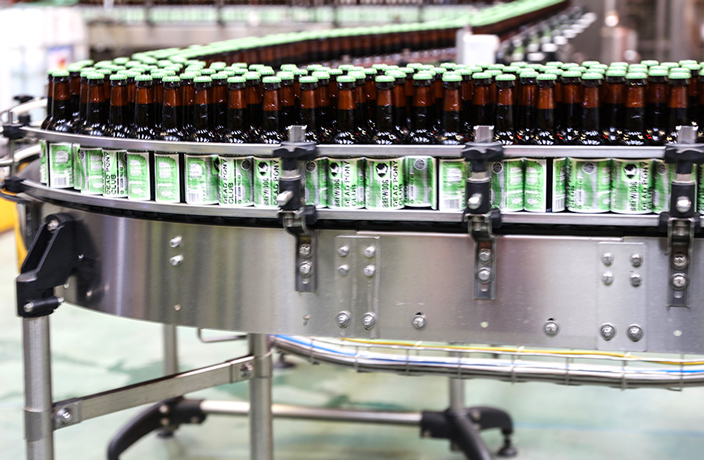
BrewDog's Dead Pony Club Pale Ale is carried down a conveyor belt at the brewery in Scotland (photo by Dai Yanxin)
As much as he loved international beers, he wanted to see China’s own beer culture take off. So he began brewing, and teaching others how to brew. He evangelized.
“In 2012, me and two other guys published an article online, and said [craft beer] should be called jingniang pijiu,” he says. “Ever since then, all the craft breweries translate it that way.”
Xiao Biar now runs two successful locations of Beijing brewery NBeer. His Wukesong branch displays his 400 bottles in a space he laughingly calls the ‘Craft Beer Museum’ (it’s a brewpub). Yet despite his success, he’s still worried about craft beer’s future in China.
“A lot of big companies are buying up Chinese craft beer,” he says. “I’m scared that if we get bought by big companies, we’ll lose our local character.”
Xiao is just one of many brewers in the capital who are now coming to terms with an increasingly competitive craft beer market. It all started with a minor craft beer boom in the early 2010s.
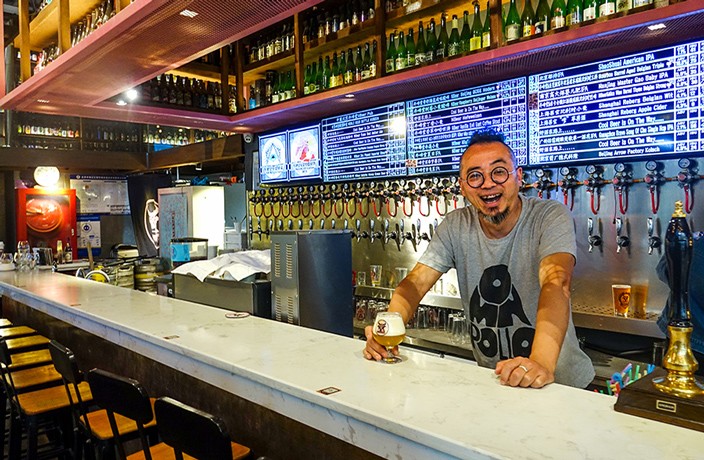
Xiao Biar poses in the Wukesong location of his brewery, NBeer
In 2010, American Carl Setzer opened the first location of Great Leap Brewing in Dongcheng’s hutongs, then second and third locations in 2013 and 2014 respectively. The popular Slow Boat Brewery opened its first taproom in 2012, followed by Panda Brew in 2013, Jing-A in 2014 and Arrow Factory in 2015. Drinkers have since lost count of the number of the city’s craft breweries – though Zhou Jingsheng of industry website imbeer was quoted as saying “there are now over 100” by Nikkei Asian Review.
The breweries opened in such quick succession that international media took notice. “As China's craft beer craze takes off, brewers hatch ambitious plans,” reads a 2016 headline from The Globe and Mail. “A craft-beer boom with Chinese characteristics,” reads another from The Economist.
“The number of beers that are coming to China is increasing every single day. No matter how big or small the brewery is, they want a piece of the market”
China’s homegrown craft beer had become popular. But then, it got complicated. Or, as a New York Times headline puts it: "China Embraces Craft Beers, and Brewing Giants Take Notice.”
Today, China’s craft beer scene is far more than local brews, as global brewing companies try to get in on the growing market. In 2016, international brewing giant AB InBev launched its Goose Island beers across the country and purchased Shanghai’s Boxing Cat Brewery the following year. The company, which makes Budweiser, also announced new, high-volume brewing facilities in Hubei province as well, in addition to its massive Fujian production facility. (“The big trend with Chinese consumers is that they want better experiences, and we see this momentum remaining in China for the next 10 years. That’s what we’re here for,” says Rafael Pizzatto, operations director at ZX Ventures, the company's craft beer arm.)
But AB InBev is far from the only beer seller targeting Chinese markets. And as increasing numbers of foreign companies court Chinese drinkers, many in the country are wondering what that means for the future of homegrown beer brands.
“The number of beers that are coming to China is increasing every single day,” says Phi Kwan, who goes by PK, co-owner of a craft beer bar in Guangdong. “No matter how big or small the brewery is, they want a piece of the market.”
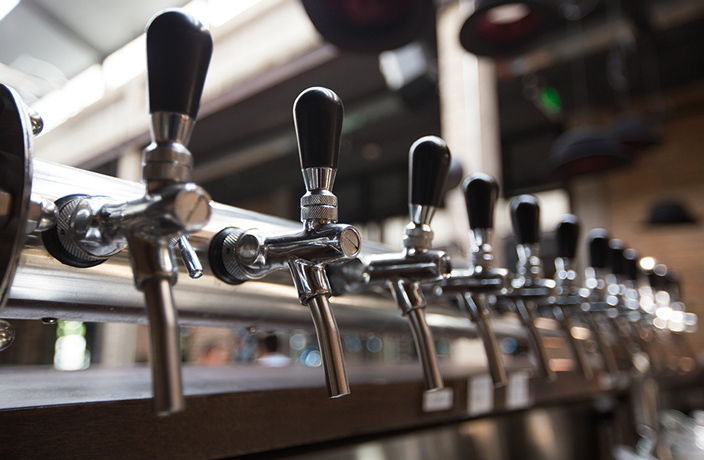
PK lives in the smaller city of Jiangmen, yet Guangzhou- and Shenzhen-based distributors and sales reps approach him every week. His bar, TapHouse, sells craft beers from around the world on 12 different taps.
Before opening TapHouse, PK and his partners visited breweries around the region for research – but for now, all the beers they sell are made abroad.
“We are trying to get more local breweries in, but the support is minimal,” he explains. “It’s not pay-as-you-go or pay-as-you-sell. It’s all cash on demand, and there aren’t a lot of accessories. Their beers are top notch, they just cannot compete with multinationals.” PK’s sweet spot, then, is BrewDog beers – a craft beer brand from Scotland whose presence is expanding rapidly in China. “They have glasses, full pint glasses, half-pint glasses, coasters, tap handles… a lot of stuff. Any beer that wants to come into my bar should at least have glasses. If they don’t have any accessories, it’s very very hard for me to sell to customers.”
Last month, BrewDog flew PK – along with a cohort of China-based bar owners and beer distributors – to their Scotland headquarters. On a cold, windy day, the cohort were driven from Aberdeen to the satellite town of Ellon, where, 10 years ago, BrewDog founders James Watt and Martin Dickie were once the company’s sole employees (it now employs over 800 people).
“We are trying to get more local breweries in, but the support is minimal. Their beers are top notch, they just cannot compete with multinationals”
Beijing resident Dai Yanxin, or Daisy as she goes by, was in the same group. “TopShelf, [BrewDog’s] China distributor, reached out to me and said, ‘hey, you can be a selected customer to go to the brewery in Scotland,’ and they’re happy to pay my flight and three days’ accommodation. And I thought, why not?” she tells That’s. As an editor for beer publication imbeer, and co-owner of Jianguo Bar, in the capital’s hutongs, Daisy had even interviewed BrewDog cofounder James Watt on his 2016 trip to China. “I even paid extra for an express visa,” she says.

Dai Yanxin's bar, Jianguo Bar, serves over 200 varieties of craft beer
She, PK and the rest of the China cohort were in Scotland for BrewDog’s Annual General Meeting, a (rowdy, beer-soaked) gathering of company shareholders in Aberdeen.
The shareholders, or ‘Equity Punks’ in BrewDog parlance, buy small shares of the company in exchange for beer discounts (which vary depending on how many shares they’ve bought), plus an invitation to the raucous AGM. The funding scheme is pitched as an alternative to getting bought out by larger corporations like AB InBev, a phenomenon that hit China last year when the company bought Shanghai’s Boxing Cat Brewery.
After a joke-riddled business presentation by the BrewDog founders, the Equity Punks slammed beers, rocked out to punk music and, most interestingly, lined up for a haunted house labeled the ‘House of Bad Beers.’ Inside, fake mummies and corpses were set up to look like they’d been murdered by AB InBev brands, such as Stella Artois and Budweiser.
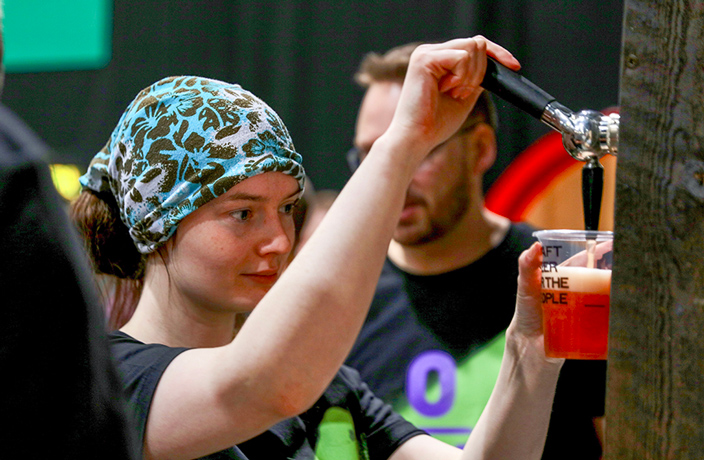
A BrewDog employee serves beer at company's Annual General Meeting
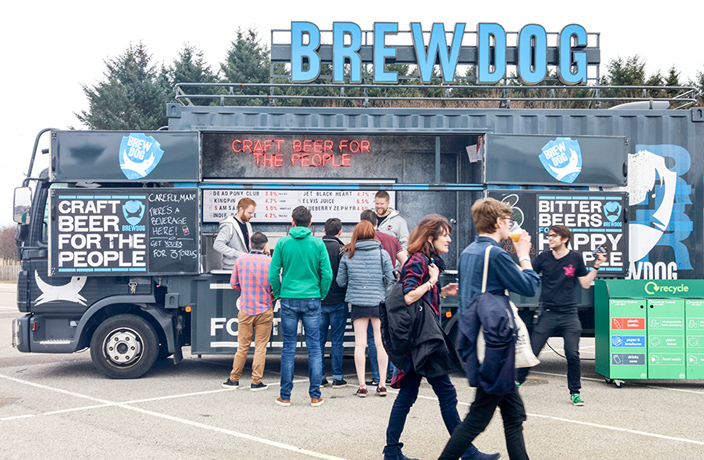
The 'Equity Punks' drink beer at their Annual General Meeting
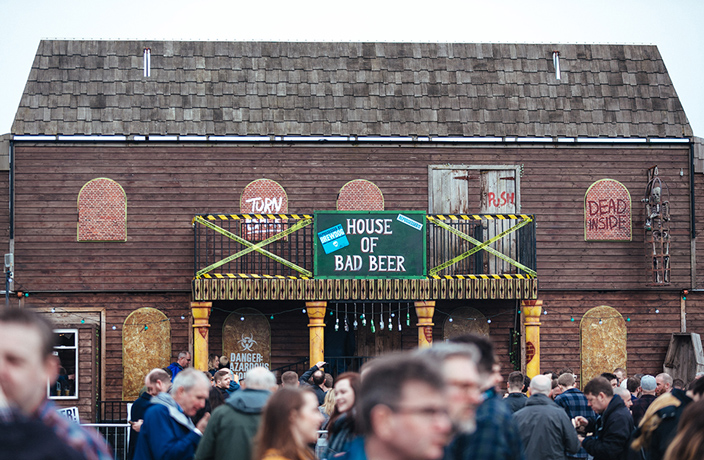
BrewDog's shareholders, known as 'Equity Punks,' line up for a haunted house that pokes fun at corporate-owned beer brands
“Think you have to be a little bit drunker to enjoy that,” one man cracked as he exited.
Or, maybe, you just have to be a craft brewer. Great Leap Brewing founder Carl Setzer has spoken out many times about his concern for the future of China’s craft beer in light of AB InBev’s moves in the country.
“By the American Brewer’s Association and a handful of other trade groups around the world, including the Craft Beer Association of China, as soon as you sell to ABI, or any other commercial brewing concern, you stop being craft,” Setzer says.
In September of last year, Fortune published an article titled “AB InBev: China’s New Craft Beer Bully.” The article alleged that the multinational company’s buying up of local brands would undermine China’s nascent beer industry.
“The explosion of interest in China is built on the back of local Chinese craft breweries that improve the market and give distributors and brand ambassadors and importers an opportunity,” Setzer tells That’s. “[AB InBev’s] Goose Island wouldn’t be in China right now if it wasn’t for Boxing Cat, Jing-A and all these other brands.”
Setzer has been particularly vocal about the challenges ahead for China-based microbreweries since Boxing Cat sold to AB InBev. As Setzer writes on the Great Leap blog, Boxing Cat co-owner Lee Tseng called to tell him the news last February:
“He usually doesn’t call. He just got out of the hospital and I thought something was really wrong. I answered the phone by asking him if he was dying, ‘No, Carl, I’m not dying, but I have something to tell you.’
‘Oh f*ck you, you’re selling to ABI aren’t you?
‘Yes.’
‘I f*cking hate you. Congrats, f*ck you though. F*ck.’”
“The explosion of interest in China is built on the back of local Chinese craft breweries”
This year, Setzer organized a panel at the Beijing Invitational Craft Beer Festival to seriously discuss what BrewDog’s ‘House of Bad Beers’ had mocked. “There are attempts to influence [the craft beer] market by a glorified beverage bank that wants to increase the value of one or two of their brands by taking food out of the mouths of craft brewers,” he said in his opening statement. “None of us wants ABInBev to stop making high quality beers. We just want them to tell us the truth. Where is it brewed? Who owns it? And, ultimately, what’s your objective?”
“I think it is important to remember that consumers do care about who you are and what you’re doing and what your story is,” added Kate Brankin, of Chicago’s Pipeworks Brewing Company. “I think calling out a lack of transparency for what it is can be important.”
ZX Ventures, AB InBev’s craft beer division, don’t see it that way. As they say in a statement to That’s: “We are here for the beer and for the beer lovers. Our mission is to provide the best beers and beer experiences across the country. Our brewers innovate and work under the guidance of the highest quality standards in the industry.”
Indeed, consumers seem to be responding well. Goose Island’s sales have only risen in the past few years, and the brand even opened a successful brewpub in Shanghai. Li Wei, co-owner at Beijing’s Peiping Machine Brewing, sells it on his taps, alongside other ZX Ventures-led brews.
“There are some people who say AB InBev is bad for China, but I don’t think so,” he says. “They sell good beer. I think there’s plenty of room for everyone.”
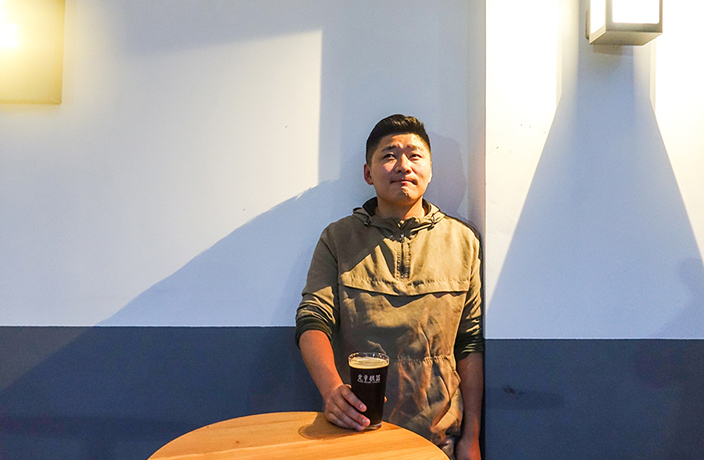
Li Wei stands outside
the brewpub he co-founded, Peiping Machine
Brewing
For beer bars, there are plenty of reasons to stock AB InBev brands. For one, the company hosts major promotional events, and holds guided tastings.
“We go into a city with the brewmasters and we do a weekend of events, where we take over one bar or one location that is a good partner of ours, and then we invite consumers to taste a lot of beers, and then they can see the brewmasters explain the different styles,” says Pizzato of ZX Ventures. “We went to 10 cities with Boxing Cat, and we had [brewmaster] Michael Jordan at every event to explain the beers, so it’s super connected to beer education.”
Beer education is especially important when it comes to beer sellers in smaller cities, where consumers are often less familiar with the concept of craft beer than they are in hubs like Beijing or Shanghai. In Jiangmen, PK knows this struggle firsthand.
“Before I opened my bar, there were only a couple places that had IPAs at all in Jiangmen,” he says of his adopted home city. “And they were only in bottles. And that’s in a city of 5 million!”
“I think it is important to remember that consumers do care about who you are and what your story is”
Indeed, for all the buzz over a Chinese craft beer ‘explosion,’ craft beer still only makes up a tiny percentage of China’s overall beer market. Tsingtao, Snow and other lagers still reign supreme. While there’s no official stat on what percentage craft takes up, global drinks analyst Jonny Forsyth speculated for Fortune in 2017 that “it might be 0.1 [percent].”
“When we look at the craft beer market in China, it’s still well in its infancy stage, where the majority of the consumer market still either does not know much about craft beer or they’re just starting to dabble in expanding their palette,” Pazzato says. “That’s why we are working so hard to promote the craft beer culture here.”
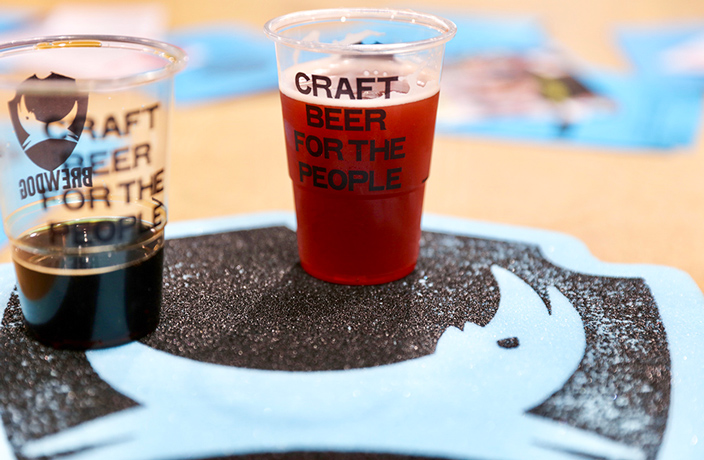
BrewDog beers are served at the company's Annual General Meeting in Scotland (photo by Dai Yanxin)
Back in Beijing, Xiao Biar is also working hard to promote craft beer culture – just differently.
“I really hope companies don’t buy all the smaller breweries,” he says.
The way he sees it, the future of craft beer in China could go one of two ways. “Maybe large companies from abroad will take over everything, and that would be terrible,” he says.
“Or,” he says, more hopefully, “Chinese craft beer will grow, and become the best craft beer in the world.”
Then, upon further thinking, he presents a final option. “Or we’ll all die before then,” he says, laughing.
“That’s not funny!” I protest.
“No, it is!” he says. Then he goes and gets us a round of beer.
[Top image via Flickr]
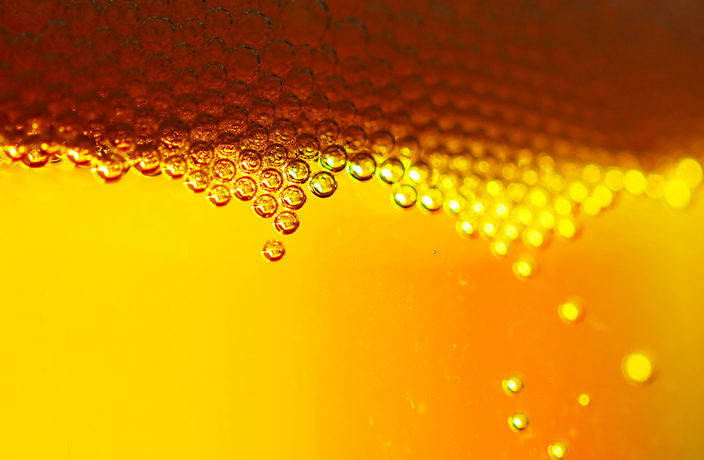




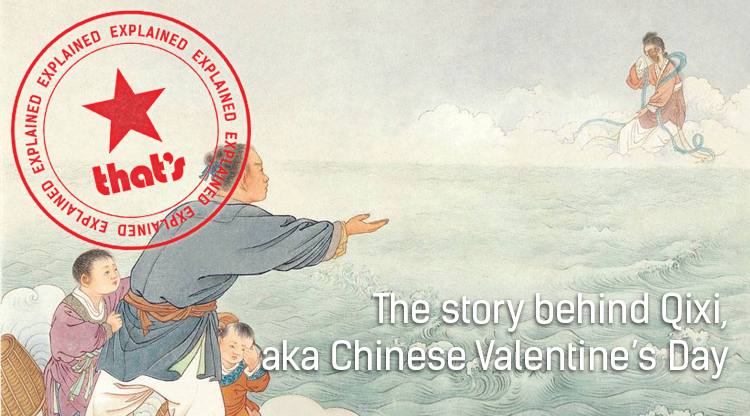
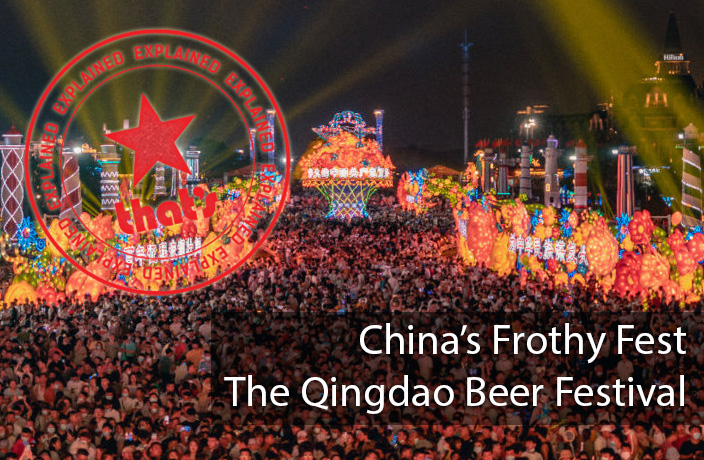















0 User Comments